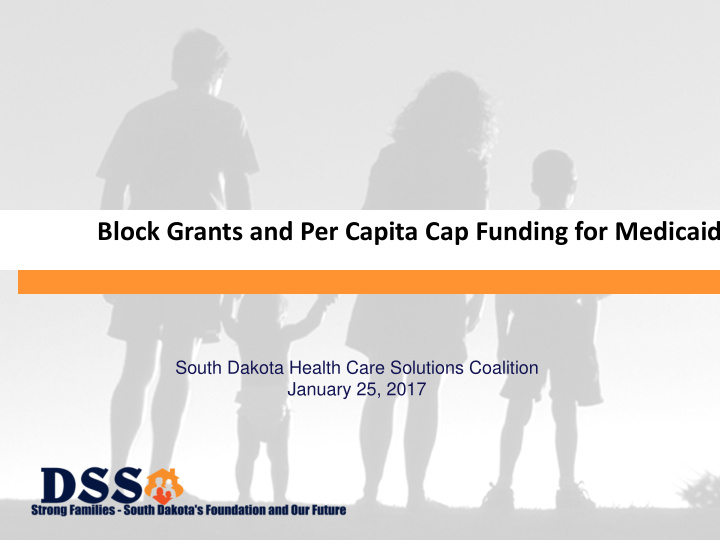



South Dakota Department of Block Grants and Per Capita Cap Funding for Medicaid Social Services South Dakota Health Care Solutions Coalition January 25, 2017 1
Medicaid - Current Financing Structure Medicaid is the largest source of federal revenue to states – $346 billion (federal funds) in 2015 Medicaid is an entitlement program – all eligible individuals must be served. Federal requirements establish minimum income guidelines, coverage groups, and services. States have flexibility to provide coverage or set income guidelines resulting in wide variability in coverage and costs. States must follow federal rules – obtain approval through Medicaid state plan 2
Current Financing Structure Matching federal payments to states with no current cap. Federal Medical Assistance Percentage (FMAP) determines how much the state and federal government pay for their share of Medicaid expenditures. • Determined annually for the federal fiscal year (10/1 – 9/30) using previous 3 year’s personal income data from each state. • Formula compares each state’s average per capita income change in relation to each other. South Dakota SFY17 FMAP Medicaid (Title XIX) 45.89% general – 54.11% federal CHIP (Title XXI ): 9.12% general – 90.88% federal Nationally FMAP rates range from 50 – 74% for services Administrative costs 50/50 3
Block Grants Federal block grant refers to a grant program that provides federal assistance for a broadly defined function to meet a program goal . Includes requirements regarding target populations, allowable expenditures. Provides funding certainty to federal government; shifts risk for enrollment increases and health care costs to states. 4
Block Grants Amounts allocated among states typically established on historical expenditures in a base year. May remain flat or level funded – or have some inflationary factor applied each year. Some block grants provide a fixed amount of federal funding not conditioned on state spending or match. Some block grants require a maintenance of effort or match of state funds. – TANF block grant provides federal funding at the capped level so long as the state spends minimum amount of its own state dollars on TANF-related initiatives – Child Care block grant – match rate set annually based on FMAP 5
Block Grants Total dollars of federal funding for TANF and Social Services block grants have declined in value due to inflation 6
Per Capita Caps Under a Medicaid per capita cap, the federal government would set a limit on how much to reimburse states per enrollee. – A per-beneficiary federal cap would be determined for a base year; adjustments made annually based on a federally-determined growth limit. – There could be one uniform cap for all enrollees or a separate cap for each eligibility group (aged, individuals with disabilities, adults, children) Still shifts risk of cost but does account for changes in enrollment- includes similar risks to block grants if per capita amounts aren’t adequate to fund services. 7
State Considerations Either approach reduces federal payments to states 8
State Considerations How allotments are set – Historical spending per enrollee would generally favor states with more comprehensive coverage, higher income guidelines, more favorable reimbursement rates, etc. – State policy decisions drive a wide variability in per enrollee cost. – Include/exclude supplemental payments such as graduate medical education, disproportionate share payments, funding for American Indians served by IHS How allotments will be adjusted over time State spending requirements - i.e. Maintenance of effort or match Required services, populations, income guidelines 9
State Considerations Both approaches fail to address issues beyond state control Neither block grants nor per capita cap account for: – New drugs or other medical advances, public health crisis (flu outbreak), or sicker populations. If funding doesn’t keep pace with enrollment or costs, result is states must choose between – Reducing eligibility – Reducing coverage or services – Reducing provider rates – Waiting lists 10
State Considerations 11
Recommend
More recommend